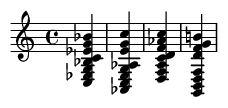Summary:
The i-VI-ii-V7 is one of jazz's most elegant and emotionally resonant harmonic sequences. Rooted in the minor key, this progression masterfully blends the somber quality of the tonic with a moment of brightness from the VI chord, before moving through the classic tension of the minor ii-V7. This creates a sophisticated sound, essential for jazz ballads, the Great American Songbook, and modern sophisticated pop.
Keywords:
i-VI-ii-V7 progression, minor key jazz harmony, minor ii-V-i, jazz ballad chords, harmonic analysis, voice leading, chord substitution, music theory
Introduction:
In the world of jazz harmony, few progressions can evoke such a rich palette of emotion as the i-VI-ii-V7. While its major-key cousin, the I-vi-ii-V, is the bedrock of countless upbeat pop and doo-wop tunes, this minor key variant offers a deeper, more introspective journey. It's the sound of longing, of bittersweet memories, and of sophisticated storytelling in music. This article will deconstruct the progression, explore its theoretical underpinnings, and provide practical examples for you to use in your own playing, composing, and improvising.
Harmonic Structure and Theory
To understand this progression, let's analyze its components in the key of C minor. The common jazz version uses seventh chords, adding harmonic richness. The full progression is: Cm7 – Abmaj7 – Dm7b5 – G7.
These chords are derived from the minor scale and its variations:
- i7 (Cm7): The tonic minor chord, establishing our home key of C minor. It comes directly from the C natural minor scale (C, D, Eb, F, G, Ab, Bb).
- VImaj7 (Abmaj7): The submediant chord, also from the C natural minor scale. This major 7th chord provides a surprising lift and a moment of brightness, connecting to the relative major key (Eb major, where Ab is the IV chord).
- iiø7 (Dm7b5): The supertonic half-diminished chord, also known as iiø7. It's the diatonic ii chord in natural minor and acts as the primary subdominant or predominant chord, setting up the dominant.
- V7 (G7): The dominant seventh chord. To create a strong pull back to the tonic, we need a leading tone. The B-natural in the G7 chord is borrowed from the C harmonic minor scale (C, D, Eb, F, G, Ab, B), creating powerful tension that demands resolution to C minor.
The i-VI-ii-V7 Progression in C Minor
This example shows the progression with standard jazz voicings for piano.
The Importance of Voice Leading
One reason this progression sounds so satisfying is its impeccable voice leading. The notes within the chords move smoothly, often by step or half-step, creating a strong melodic connection between harmonies. This "melodic gravity" pulls the listener through the progression. Notice the smooth lines and common tones in this four-part vocal-style example.
Example of Smooth Voice Leading

Famous Examples in Jazz and Popular Music
While the minor ii-V-i is everywhere in jazz, the full i-VI-ii-V progression is a more specific and special device. It's often used as a foundational element in the opening phrases of songs or as a sophisticated reharmonization.
- "My Funny Valentine" (Rodgers and Hart) : This is the textbook example. The iconic opening four bars are a direct i-VI-ii-V in C minor: Cm - Abmaj7 - Dm7b5 - G7 (often with melodic variations like Cm(maj7)).
- "Autumn Leaves" (Joseph Kosma): While the main progression differs, the crucial minor key section is a iiø7 - V7 - i. Jazz musicians frequently reharmonize the opening tonic minor chord to create a full i - VI - ii - V cycle to add harmonic motion.
- "Softly, as in a Morning Sunrise" (Sigmund Romberg): The A section uses a similar progression: Cm - Fm - G7 - Cm, which is i - iv - V - i. A common substitution is to replace the iv chord (Fm) with the VI-ii (Abmaj7 - Dm7b5), transforming it into our target progression.
Improvisation Strategies: Scales and Arpeggios
Improvising over this progression is a great way to practice navigating minor key harmony. Instead of thinking of one scale for the whole thing, target each chord with its corresponding scale or mode. In C minor:
- Over Cm7 (i7): Use the C Aeolian Mode (Natural Minor) or C Dorian Mode for a slightly brighter sound. C Minor Pentatonic is always a safe and effective choice.
- Over Abmaj7 (VImaj7): The Ab Lydian Mode (Ab, Bb, C, D, Eb, F, G) is a perfect fit. The raised 4th (D natural) sounds beautiful and avoids clashing with the Dm7b5 that follows.
- Over Dm7b5 (iiø7): The D Locrian Mode (D, Eb, F, G, Ab, Bb, C) is the theoretically correct scale. Focusing on the chord tones (D, F, Ab, C) is a more direct approach.
- Over G7 (V7): This is where the magic happens. You have many colorful options:
- G Mixolydian b9 b13 (Phrygian Dominant): Derived from the C Harmonic Minor scale.
- G Altered Scale: G, Ab, Bb, Cb, Db, Eb, F. The ultimate tension scale.
- G Half-Whole Diminished: G, Ab, Bb, B, C#, D, E, F. A symmetrical scale full of tension and resolution possibilities.
Chord Substitutions and Variations
Jazz musicians rarely leave a progression untouched. The i-VI-ii-V is ripe for reharmonization. A common technique is to insert secondary dominants or tritone substitutions to create more chromatic movement.
One classic substitution replaces the VImaj7 chord with the tritone substitute of the V7 of the ii chord. That sounds complex, but it's logical:
- The chord we are moving to is Dm7b5.
- The dominant (V7) of Dm7b5 is A7.
- The tritone substitute of A7 is Eb7.
Substitution Example: i - subV7/ii - ii - V7
Learning and Teaching the Progression
For students of jazz, mastering this progression is a rite of passage. Here's a recommended learning path:
- Play the Basic Chords: Use a piano or guitar to play the basic seventh chords in C minor until you can hear the emotional arc.
- Transpose to All 12 Keys: This is crucial. Internalize the sound and function of each chord (i7, VImaj7, iiø7, V7) regardless of the key.
- Analyze and Learn: Find the progression in tunes like "My Funny Valentine." Learn the melody and see how it interacts with the harmony.
- Practice Improvisation: Start by using arpeggios of each chord. Then, gradually incorporate the scales and modes discussed earlier. Record yourself and listen back.
Conclusion: An Essential Piece of the Jazz Language
The i-VI-ii-V7 progression is more than just a series of chords; it's a complete musical narrative. It begins in a place of minor-key contemplation, lifts the listener with a moment of unexpected brightness, builds tension through the classic minor ii-V, and then resolves satisfyingly back home. Its blend of logic, smooth voice leading, and emotional depth makes it an indispensable tool for any serious student of jazz harmony. By understanding and mastering this progression, you unlock a deeper connection to the heart of the jazz ballad and the sophisticated language of the Great American Songbook.
References:
Levine, Mark. (1995). The Jazz Theory Book. Sher Music Co.
Rawlins, Robert & Bahha, Nor. (2005). Jazzology: The Encyclopedia of Jazz Theory for All Musicians. Hal Leonard Corporation.
Coker, Jerry. (1997). Elements of the Jazz Language for the Developing Improvisor. CPP/Belwin.
Terefenko, Dariusz. (2014). Jazz Theory: From Basic to Advanced Study. Routledge.
